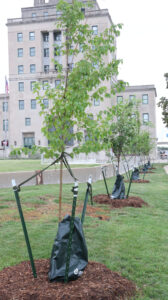The center section of Mays Island has stood for decades as a largely underutilized greenspace in the heart of Cedar Rapids, save for an underground municipal parking garage.
But with 26 new trees funded by the America in Bloom program and a ribbon-cutting for the bold new “Cedar Rapids” sign created by the Downtown Self-Supporting Municipal Improvement District (SSMID), local leaders are developing a dramatic re-envisioning plan to boost public usage of the space.
At a recognition event for the $25,000 America in Bloom grant June 24, Cedar Rapids mayor Tiffany O’Donnell said the new trees, planted in cooperation with the Downtown SSMID, represent a milestone in the ongoing re-establishment of the city’s tree canopy, nearly five years after the August 2020 derecho destroyed an estimated 670,000 trees.
“Our celebration today really does mark another meaningful chapter in that journey,” Ms. O’Donnell said, “and it’s proof of what can be possible when a community comes together with its public partners as well as its private partners with intentionality, purpose and care … in addition to strengthening our environment with cleaner air, we know all the benefits trees can bring, a live and bright canopy. This also does support our work of our longer-term Downtown Vision Plan here in the heart of our city, bringing new energy and what we know will be activity and everyday use to Mays Island.”

The grant, awarded in partnership with America in Bloom and CN Railway, funded the planting of 26 new trees on Mays Island, as well as their ongoing upkeep.
City administrator Jeff Pomeranz said the new trees on Mays Island are part of the ReLeaf Cedar Rapids campaign, a public-private partnership between the City of Cedar Rapids and Trees Forever created to guide the city, non-profit organizations, institutions, and private landowners in replanting the city’s urban canopy. He also noted that local benefactor Clark McLeod is developing a similar initiative to plant new trees on private property throughout Cedar Rapids.
“We’re going to bring our tree canopy back,” Mr. Pomeranz said. “It’s going to take a little bit, but we’re making progress.”
He also discussed plans to put Mays Island to “better utilization,” including elements such as artwork, murals, public seating areas and even a potential sculpture garden, inspired by city leaders’ visit to the National Gallery of Art’s Sculpture Garden in Washington D.C., which includes a sculpture reimagining Rodin’s “The Thinker” – funded by Des Moines native and entrepreneur John Pappajohn.
Dr. Marvin Miller, treasurer and chair of the America in Bloom grant committee, said Cedar Rapids has received grants from America in Bloom in the past, and was scheduled for another tree-planting effort in conjunction with Hughes Nursery before that plan was interrupted by the 2008 flood.
He talked about America in Bloom’s focus on three primary benefits of the “power of plants” – environmental, economic, and health and well-being. He also noted the American organization was modeled after similar programs worldwide, from “Communities in Bloom” in Canada to “Britain in Bloom” and programs throughout Europe and Asia.
America in Bloom executive director Laura Kunkle said the organization’s competitive grant program is conducted in collaboration with CN Railway to provide beautification and other grants to communities along their rail corridors nationwide. She also said only 10 grants are awarded through the program each year.
“There’s a lot of cities along the rail corridors that need the money, but we can only offer 10,” she said. “So I want to congratulate ReLeaf Cedar Rapids for putting together a remarkable application. It was a no-brainer when the committee read it … the derecho was devastating, and we want to be a small part of helping you revive your tree canopy.”
James Klein, chair of the Cedar Rapids Downtown District commission, said the new trees, along with the new Cedar Rapids sign recently installed on Mays Island, are part of the district’s plan to “activate” Mays Island as part of the overall Downtown Vision Plan, which now includes standing monthly meetings with key stakeholders to discuss updates.
“We have a ton of accountability,” Mr. Klein said. “And as city manager Pomeranz said, we’re taking action. Enough planning. Let’s get something going. Today, the trees and the sign are a great symbol of let’s get going. Let’s do action.”
The event concluded with a formal ribbon-cutting ceremony for the new sign, which was funded by the Downtown SSMID and installed on an ADA-accessible platform built by the city.